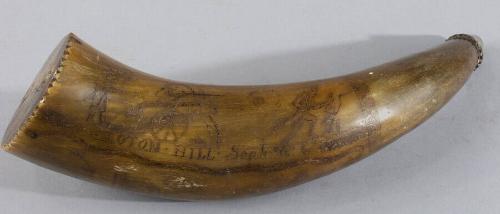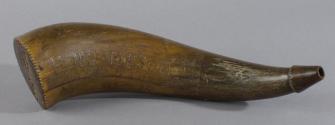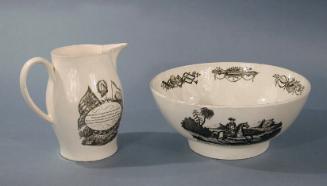Powder Horn
Original OwnerOriginally owned by
Henry Mason
(1758 - 1836)
Date1781-1785
MediumHorn, wood
ClassificationsWeapons
Credit LineThe Newman S. Hungerford Museum Fund
Object number2012.571.0
DescriptionCarved powder horn featuring a tapered spout with chip carved decoration continuing into the scribe decorated body showing a chip carved edge surrounding the fitted wooden plug. The inscriptions on the powder horn include the owner's name, "HENRY MASON' in block letters with flourishes, over the location and date, "Grotan Hts: 1781", [sic] flanked by geometric decoration. Below the owner's name is a scene featuring a landscape with 18th century houses over a scene of two Connecticut militia men, one with his sword raised and the other firing a musket, while a cannon fires a cannon ball at tow retreating English soldiers. The scene is over the inscription "Groton Hill, Dept. Ye 6t." Below the battle scene and near the tapered pout is an early Federal eagle with spread wings and surrounded by the inscription "America, Libertas, Jusititia", opposite the eagle and near the wooden plug end is a large sun with face flanked by flowers.
The horn is marked "HENRY MASON / GOTAN HTS 1781" [sic] and bears an engraved battle scene featruing an artillery piece as well as British infantry, the scene captioned "GROTON HILL Sept Ye 6th". Other imagery includes a Rising Sun design titled "AMERICA" and a variety of animal and vine imagery typically found on horns of the period, and also the words "LIBERTY" and "JUSTICE".
The horn is marked "HENRY MASON / GOTAN HTS 1781" [sic] and bears an engraved battle scene featruing an artillery piece as well as British infantry, the scene captioned "GROTON HILL Sept Ye 6th". Other imagery includes a Rising Sun design titled "AMERICA" and a variety of animal and vine imagery typically found on horns of the period, and also the words "LIBERTY" and "JUSTICE".
Label TextHenry Mason was a militia artilleryman from Groton, Connecticut who was among the defenders of Fort Griswold during the British attack now known as the Battle of Groton Heights, that claimed so many lives. Published accounts indicate that Mason was wounded in the attack, but in his pension application he mentions that he was fortunate to escape injury. He was taken, with others captured that day, and sent to New York where he was confined in the notorious Sugar House prison for two months. He was exchanged and returned home to Groton in the winter of 1781-82. The powder horn was not used at the time of the battle, but made after the fact, commemorating the event.
NotesOwner Note: Henry Mason (1758-1836) is documented as a member of the Connecticut Militia engaged in the Battle of Groton Heights on 6 September 1781. His brief biography is listed in "The Battle of Groton Heights" by Charles Allyn, 1882, pp. 236-237. (Lee 3/6/2013)Status
Not on viewDr. Cyrus Pendleton














